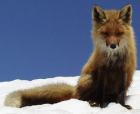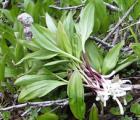
Biscuit Chomps Bear Plant

Squint, the Fox

Wild Garlic
(Click on any Image to see a higher resolution version)
We spotted the cubs along the shore of the small lake just east of camp at 9:30 AM yesterday morning. Fog had been drifting in and out all night and we were anxious to spend some time seeing what life was like with the cubs. Biscuit was busy scooping down into the grasses in 2 feet of water at the lakeshore. Beautiful strings of salamander eggs came up in her delicate claws. She savored every mouthful. Chico was off on the tundra nearby, which is lush with yellow rhododendrons. Never have wee seen so many in bloom as this year. Chico nipped off the occasional bloom and proceeded to forage on "globe flower " buds and leaves. Mist rolled off Kambalnoe Lake in the distance. We strolled along the lakeshore to Brandy Bay. Chico was adamant that she could get the decayed salmon off shore but every time she picked one up off the bottom of the lake, it would disintegrate. There must have been a late run of sockeye last fall as we could see quite a few rotting fish in much deeper water. Biscuit was either saving her energy or didn't like the cold water and waited on shore much like cubs normally do with their mother; leaving the mother to do all the fishing (in this case it was Chico out doing the cold work). They soon tired of these meager scraps. To my delight one of the foxes I had come to know last summer was 10 ft. up slope from the cubs. I was praying the fox wouldn't be viewed as another meal option.
I called this fox "Squint" last year as she has a more extreme way of closing her eyes when looking at me than other foxes I have come to know. Squint obviously was in a mood to tease the cubs. It ran up behind Chico to about 6 ft. Both cubs gave a halfhearted chase, quickly giving up. Squint came over to me and seemed to enjoy my greeting. I think she may have pups this year. She lay in the snow, rolling about, enjoying all the attention. Squint likes to hear me talk in what Charlie calls my "high squeaky voice" about as much as the cubs do. I think animals in general, like attention that is kindly offered and enjoy the voice, eye contact etc. I have visited all the den locations of the three fox families I identified last year. Little devils have moved again. A silver fox and its red mate go by the cabin regularly and I will track them soon to see if I can spend some time with a family of kits as I did last year. When I first found a litter last year there were 4 kits playing at the den site. By the end of August only one had survived. They move their family around regularly when they are a bit older to avoid predators picking up too much scent at one location, I think!
I have become intrigued about the diet of our cubs over this year more than ever. When we first observed them, they were in amongst the scrub alder eating two different species of grass and sedge. Thanks to the suggestion of Charlie's bear biologist brother, Dick, I am collecting samples of everything I see the cubs eat (yes Dick, this year I am gathering the root system, stem, leaves and flower if available!). I have a makeshift press up in the rafters of the cabin. One week later, their diet has already expanded. They are extending their feeding area to south facing slopes and including globe flower blossoms and leaves, "bear plant" stems, another plant's stem with leaves that look like raspberry leaves. Judging by their activity level, with lots of wrestling and sliding on the snow still left in the gullies; they are full of what they need.
Over on Biscuit Mountain, which we can observe from the cabin roof, I was trying to catch a few rays of sun while pondering the state of my very bad painting in the "artist's cabin" below. I spotted the cubs about half way up, string intently into the dense alder, which is just now coming into leaf. A young dark bear emerged and headed for them at the run. They ran down the snow slope, across another alder patch, up another snow slope and stopped. As it gained on them I realized it was likely a cub newly weaned from its mother and likely a small 3-year-old. Earlier I had observed a mother with a dark cub off in the distance. A big male was close to this female and she had wisely chased off her infant. This is rather normal behavior for grizzlies. They usually come into estrous again when their cubs are 2 or 3 years old. We have observed mothers joining up with their cubs again after the courtship period, but this is not so common. This little bear was clearly looking for a friend, but ours were terrified. Finally the chase had gone on for long enough. Both Chico and Biscuit stopped. The visitor stopped. The chase reversed. Chico and Biscuit tore after this fellow and chased it about 1/3 of the way up the hill. I laughed my head off! Soon all three stopped. Chico flopped down to sleep, Biscuit went to eat greens and the interloper headed at a more leisurely pace, up hill. I was rather pleased to see that Chico and Biscuit had defended themselves in this way.
Everyone asks us what wild plants we gather for ourselves. Wild garlic is a real favorite. It is not like the wild onion of the Canadian Rockies. It looks a bit like it is in the lily family. I gather it down in the alder near the lakeshore in front of the cabin. It is easy to pull out of the moss. The stems have a red outer skin and this has to be pealed off. It is beautiful to sit under the alder, out of the wind, overlooking the lake, preparing wild garlic chop up the entire plant and use it in stir fry or cook it lightly for sushi. I have seen our Russian friends dip the stems in salt and eat it raw, while drinking vodka.
This year my sister, Pat, and her husband, Joe, graciously gave us an old Coleman camp stove. This is a small unit in which we burn naphtha gas (which was also on the shipload of stuff we brought over). We had purchased a newer Coleman last year and it was hopeless. After it caught on fire many times and turned the bottoms of all the pots black, I garaged it. My family thankfully hates to throw away junk and this older model had been in Pat's basement for about 15 year. It is a winner. We still carry all our water from the lake, but this year brought in a "Brita" water filter. Last year we picked up roundworms and pin worms and decided that along with bringing some good worm medicine we would take the precaution of filtering our drinking water. The bears get worms annually and we suspect they eat mud to get rid of them. On one occasion last year I was almost that desperate myself but fortunately some anti-worm pills came down with the next helicopter. I had sent an E-mail that I had worms and described it as "the most awful thing". Our friend, Olga, responded: "Maureen, worms are merely unpleasant and rather normal here". Ugh! When I returned to Alberta in September I went into the drug store and asked the chemist about my little problem. He announced in a great loud voice that worms are common in Canada too, especially with young children.
A storm blew in last night and it is windy. West wind at about 60 knots. Good day to work on my painting. I am under pressure this year as usual. I have up to 3 big exhibitions in 1999-2000 and I want to end the series "Through the Eyes of the Bear" over the next two years. All three exhibitions will be museum type shows. This summer I plan to supplement the big piece titled, "Anthropomorphism" and work on another section "A Bear's World".
Maureen